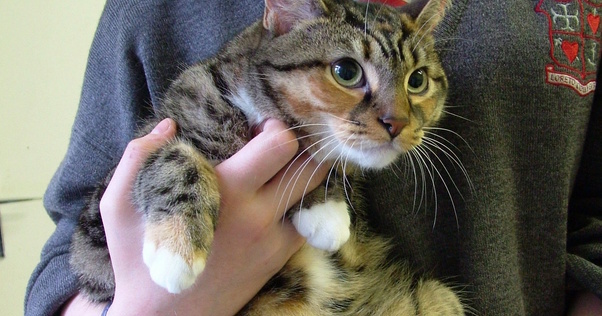Lauren’s family originally thought that Geri was a tom cat, christened Jerry after the “Tom and Jerry” cartoons. When “he” went to the vet and the truth about “his” sex was discovered, she kept her name, but it was re-spelt as “Geri”, in the manner of the ex-Spice Girl.
Geri has always been the only pet in the home, and as such, she has tended to be the centre of attention. She is a bit of a “scaredy cat”, with a nervous temperament, and she spends much of her time around the house, where she feels secure and safe. She has free access to the outdoors, but she has discovered that the Big Bad World can be a frightening place, and she prefers not to go outside. Geri gradually seems to be becoming an indoor cat by choice.
Geri recently came in for her first annual health check and vaccination. We discussed everything about Geri’s lifestyle, and I gave her a careful physical examination. She was in excellent general health, but there was one issue that I had to mention to Lauren and her family. Geri was just over one year old, but she was already showing a tendency to become overweight.
Obesity in cats is a problem that has become more common in recent years. More and more cats have become indoor pets, either by their own choice (like Geri) or on their owner’s insistence. Indoor cats tend to spend a lot of time just lying around, sleeping or eating, and so they are prone to developing a paunch. Obesity has many effects throughout the body, and in particular, cats are much more likely to develop diabetes if they are too fat. Recent studies have shown that this disease is increasingly common, paralleling the increasing girth in cats’ waistlines.
When a pet becomes fat, it can be very difficult to reverse the trend. Strict diet and exercise regimes are needed, using measured amounts of special low calorie pet food. Owners need to stick rigidly to carefully planned feeding regimes. It is far easier to identify a trend to obesity at an early stage, and at that stage to trim back a normal diet, rather than waiting until a pet has ballooned to the stage where an extreme diet is needed.
Geri is not yet obese, but she is definitely carrying more weight than she needs. If you look at her profile sideways-on when she is standing on a table, you can see that her abdomen droops down like an overstuffed pillow. And if you sit her on her rear end, as in the photo, you can see that she has a Buddha-like paunch. If Geri remained at this weight for the rest of her life, there would not be a problem, but my concern was the trend that she was following. If she is marginally plump at just over a year old, and she continues to gain weight at the same rate, she will be seriously obese by the age of four or five.
I asked Lauren about Geri’s diet, and it turned out that she has some unusual tastes. Her daily diet is healthy enough, with one sachet of moist food twice daily, and an occasional scattering of dried food to help to keep her teeth clean. But, like in humans, it is the snacking between meals that is the area to watch. Geri interacts very closely with the human family around her, and if they are eating something, she often wants to join in. She often has pieces of chicken or ham, or other nibbles that are normally part of the family meal. She also eats some foods that would not normally be thought of as attractive to cats, including rice, chips, custard and liquorice. She has a particular penchant for sponge cake, with queen cakes being her particular favourite. For Geri’s first birthday celebration that had taken place recently, Lauren had prepared a small Madeira-type queen cake, complete with a single candle. Geri had not scoffed the entire cake, but she did enjoy a few mouthfuls of sponge.
I put Geri on the weighing scales, and she is already nearly five kilograms. I judged that she is probably around 10% over her ideal weight. I have seen cats that are much, much more obese than this – I remember one fatty who was over ten kilograms before he went onto his diet. I am not too concerned about Geri, but I have suggested that Lauren and her family should make a conscious effort to focus on her weight. They need to measure how much food she is getting, and they need to cut out the high calorie snacks like sponge cake. As in humans, exercise is also important, and since Geri spends most of her time indoors, she is not burning up as much energy as a typical outdoors cat. I have suggested that efforts should be made to engage Geri in play, for fifteen minutes twice daily. Cats often respond well to toys like feathers-on-wands. Time spent dashing backwards and forwards chasing the feather is an excellent way of raising the metabolic rate and burning calories. And it is enjoyable for both cat and owner too!
I have also suggested that Geri comes back in two months to be reweighed. Her weight will always be checked once a year when she is vaccinated, but when the trend is going the wrong way, it makes sense to monitor the situation more closely. And if she does manage to get back to her ideal weight, perhaps, as a treat, she can have a little sponge cake to celebrate.
Tips
- Obesity is increasingly common in cats as well as dogs
- Indoor pets are especially prone to this, because they live less active lives
- Regular weigh-ins at the vet are the best way of monitoring a pet’s weight

